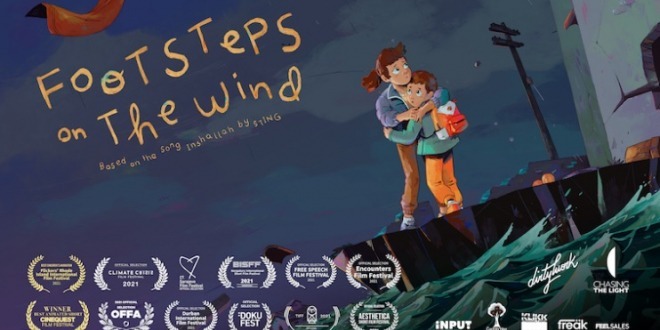Based on the harsh and intense reality of refugees around the world, this film broaches a narrative told through the eyes of children that never give up on their dreams. The Hollywood Recorder spoke with Artist and Filmmaker, Maya Sanbar.
Maya, tell us about your background.
I’m a Lebanese Palestinian multi media artist. I’m also British and French so I have accumulated a mixed background over the years!
My practice as an artist is broad, and the tools I use are adjusted to the needs and inspiration of each project. I like experimenting and pushing the scope of my own skills. I work mainly with film and sculpture, my installations are site specific and I use soundscapes as a crucial part of the energy and messaging of the work. Multi sensorial immersive installations have taken a forefront for me lately.
What led you to your film, Footsteps on the Wind.
I’ve been wanting to make a film about refugees for a while – to give a different perspective of what is reported on the evening news. I wanted to show a glimpse of life from a child’s point of view, and tell the story of what might drive people to leave their homes.
We have a family history of refuge and displacement. I was born in Beirut and my father was born in Haifa, originally from Nazareth. When my father and his family left Haifa in 1948 for a few days when they feared for their lives they were then not allowed to return to their house by Israel, they became instant refugees. Our family home to which we still had the keys and deeds was taken – and then later on the war in Lebanon also led to displacement, I’ve grown up feeling like the temporary has an unpredictable way of being permanent and that home is where you make it. I now live in London, lucky enough to have both a British and a French passport, the freedoms associated with these two nationalities I do not ever take for granted.
When I heard Sting’s song, it felt completely natural that this should be the one to make the film with.
17-time Grammy Award-winning Artist Sting gave his refugee-inspired song “Inshallah” for your film. Why was this partnership with Sting so important?
Sting’s song is so beautiful, hypnotic and deep in its simplicity. He was inspired to write it after seeing the devastating sight we all saw of bodies of children fleeing Syria drowned and washed up on the Greek shores. The melody is like the waves of the sea, immersive, reflective and sad yet hopeful because of the meaning of the word ‘if God allows, it will be so’. Sting is also passionate about protecting our fragile planet, and so the script we wrote addresses both conflict and climate refugees. Having his song highlights the awareness and compassion, and as artists that’s all we aim to do. The images speak to the song enhancing it and vice versa, it is a symbiotic collaboration.
Why did you choose animation?
Animation has a way of going beyond words, straight into the emotional. We used inspiration from classic fairytales like Alice in Wonderland, Hansel and Gretel, Jack and the Beanstalk and the Wizard of Oz. They are scary in one way, addressing the very difficult situations faced by child refugees.
It’s a big responsibility to show the refugee experience of millions of people each with their own situations, in just 6 minutes, so we have a lot of say – and with animation we were able to use symbolism and shortcuts to messaging that was important to us from our research. We made the animation very colorful and warm because the artwork that came from our storytelling workshops with refugees were extremely colorful and hopeful.
Also our aim is to use the film as a storytelling therapy tool for anyone who has experienced loss or displacement – animation has a way of depersonalizing the situation and talking about the character more easily than with live action. Animation helps find different levels of messaging in the audience whether adult or child. But most importantly the film is about unaccompanied children, we kept the camera angle low in the scenes and with animation even the sea has its own character voice, as well as does the red scarf.
Do you have a favorite scene?
One of the scenes that stays in my mind is when the children have lost their mother and the wrap themselves in her red scarf whilst looking up at the moon. There is a lot of meaning, of the eternal spirit watching over them, and their resilience in the face of adversity. I also love the underwater scene with undiscovered creatures, and the octopus in that scene also has a lot of meaning that will be understood differently depending on the age group watching it.
What is your mission for the film?
Our mission is to raise awareness and compassion, and for it to be used as a therapy tool. It will also be used as an education tool, we have a learning pack on our website www.footstepsonthewind.com
I love that we can use film, storytelling and art to shift hearts and minds, something I endeavour to do with all my work.

